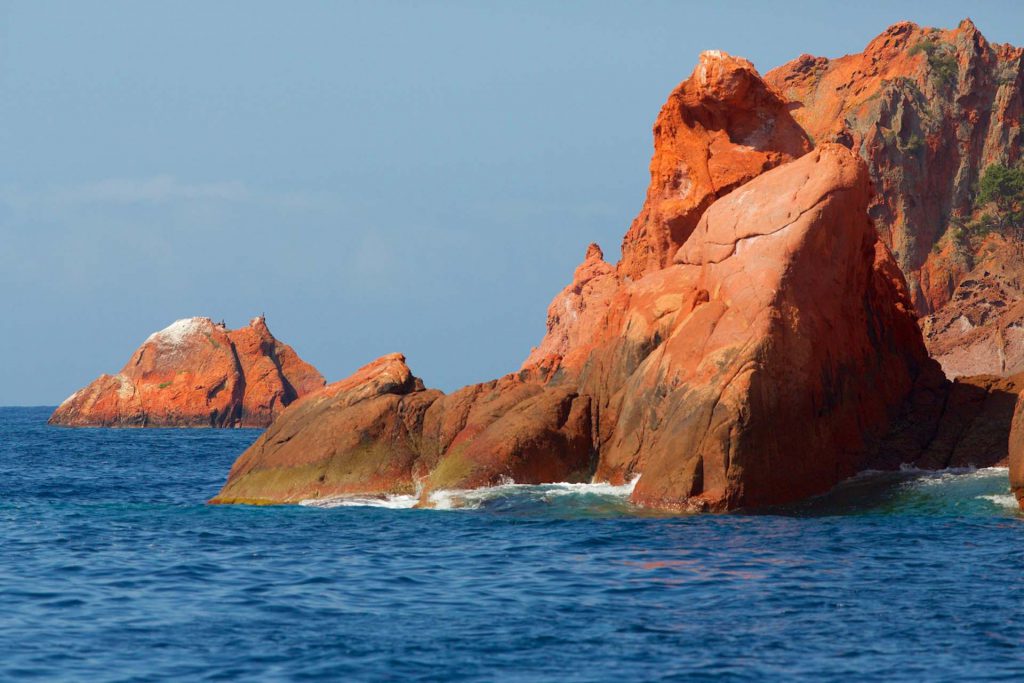Girolata is a sensitive site within the perimeter of the Regional Natural Park of Corsica and in the classified site of the Gulf of Porto Girolata. However, over the past 30 years, the number of pleasure crafts and tourist shuttles has kept growing. The number of visitors has doubled as a result of an increase in both the size and number of the boats. The number of boat trips amounted to 4,400 only for the 2008 summer season!
The town of Osani, the prefecture of Corse du Sud, the Regional Environment Directorate (DIREN) and the Regional Natural Park of Corsica have opted for organised mooring and a sensible approach to tourism management to cope with the increasing pressure from tourism, which represents a threat for the environment of the site. These steps to preserve the natural heritage of the site have been taken in concertation with the 10 permanent inhabitants and users of the site.
Setting up of organised moorings
Located at the southern tip of the Scandola reserve, this picturesque small village tucked in the scrub, among eucalyptus trees and bordered by giant red cliffs, looks over a magnificent bay, carved by turquoise waters.
The ecological moorings need to be improved
If the organization of the anchorage area has long been chaotic, things have changed since 2006. 80 paying ecological mooring buoys have been installed by the town council in the Girolata cove. The boats are moored in several rows of buoys in/out using a screw mooring. This system that resembles a giant corkscrew has been designed to penetrate the soil by screwing into it, without cutting, crushing or destructuring the constitutive elements of the tapeweed that carpets the seabed. The mooring point is made of a strap with a lifting ring mounted on the last part of the scroll. However, after four years in use, some of the screws have encountered upwards displacement. “It had to be tested to realise this state of things: this system is not adapted to the seabed of the Girolata gulf, which is sandy with a mix of gravel, rocks and meadows. Moreover, the traction caused by forward and backward mooring is permanent,” explains Jean-François Luciani, who is in charge of the harbour master’s office and whose team has quickly had to reinstall the whole mechanism supported by sea chains and dead weights of over two tons. “The global system however remains more ecological as the sea chains don’t move much and span over a linear distance of 600m. We have installed dead weights in these sandy areas without vegetation and the total footprint represents 15m2 over a 6ha stretch of water.”
Less pressure on the environment
“Overall, the setting up of the organised mooring system has brought about a sharp reduction in the anthropological pressure on the site,” says the port captain. “The growth of the tapeweed meadow is progressing, just like that of the razor fish, and there are greater numbers of dentex, mullets and barracudas than before.” According to Jean-François Luciani, the number of ships is decreasing and yachtsmen have now adopted a more responsible attitude to the environment. The place is also safer owing to traffic channels that are much more visible and facilitate the movement between boats. Ultimately, the operation has produced positive results and the municipality is satisfied with the reorganisation initiative and the income derived contributes to a better management of the site. Pleasure craft boaters have a more mixed opinion given that the space between boats is very limited during the high season. In favourable wind conditions, some of them prefer the Tuara cove, which offers a pleasant mooring spot with small caves and red-sand beaches. Even if it is less frequented, the site does not provide a safe mooring.
A dynamic harbour master’s team
Created in 2006, the harbour master’s team comprises 9 employees who are sincerely involved to make Girolata a user-friendly and preserved site. The team welcomes pleasure crafts 7 days a week from 08:00 hrs to 22:00 hrs between Easter and mid-October. From the moment they enter the Girolata cove, pleasure crafts are greeted by an agent aboard a dinghy, who guides them to their mooring spot and help them make fast. The team is particularly efficient in assisting the boats in executing delicate manoeuvres during strong wind situations.
A project of outer harbor to accomodate more boats
The land access is possible by the small and narrow docks connected to the beach edge, where the harbour master’s office is located. Visitors are informed on existing environmental regulation and available tourist services. Weather forecasts are easily available on a screen placed outside. A project to equip the outer harbour is also under way to provide access to bigger launches, with a maximum capacity of 25 persons.




